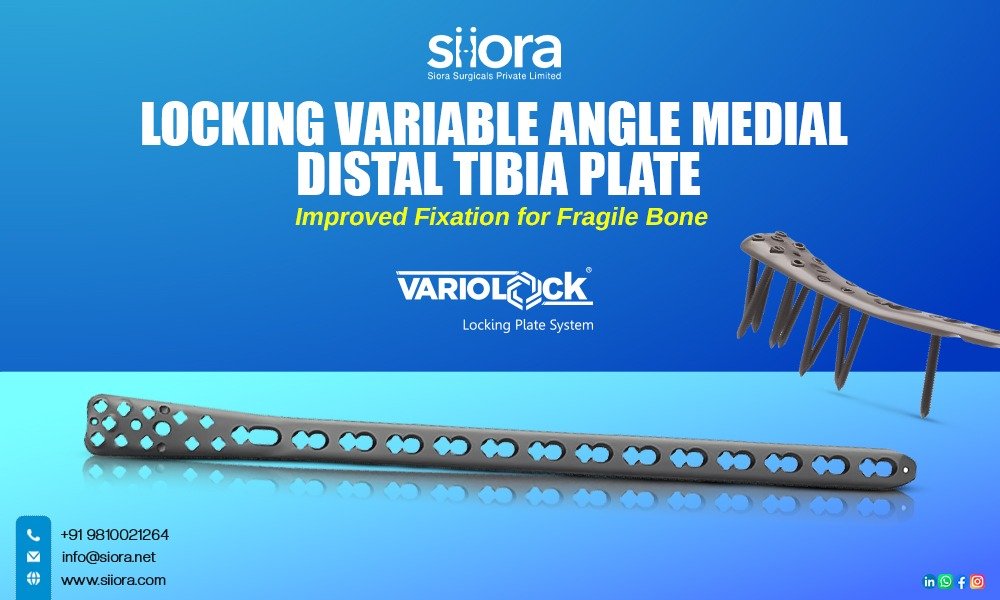Treating a fracture near the ankle joint is rarely straightforward. The distal tibia lies in a region with limited soft tissue and a delicate blood supply. Add to that the complication of osteoporosis or poor bone quality, and it becomes clear why surgeons often face setbacks with fixation in this area. Plates or nails that seem reliable in younger patients may fail in elderly ones, simply because the bone doesn’t provide strong anchorage. Over the last decade, the Locking Variable Angle Medial Distal Tibia Plate has been developed to address precisely this issue, offering surgeons more control and better stability when treating fragile bone.
Why Are Distal Tibial Fractures Difficult?
Most fractures of the distal tibia occur from either high-energy trauma, such as road accidents, or from simple falls in elderly patients with weakened bone. Unlike fractures higher up the leg, these breaks test a surgeon’s patience because they are prone to malalignment, delayed union, or even non-union. Traditional plates that rely on compression screws often do not hold up well when the bone stock is thin. This challenge has pushed implant innovation in the direction of locking technology.
What Sets the Locking Variable Angle Plate Apart?
The real advantage of this implant lies in the name itself—“locking” and “variable angle.”
- Locking screws: Once screwed into place, they don’t rely solely on bone quality for stability. Instead, they form a fixed connection with the plate, creating a stronger construct.
- Variable angle option: Rather than forcing every screw to follow a rigid trajectory, surgeons have the freedom to angle screws within a defined range, usually about 15°. This flexibility is crucial when dealing with comminuted fractures or bone that cannot support a straight-line purchase.
- Anatomical build: The plate is shaped to follow the natural contour of the medial tibia, reducing the amount of intraoperative bending needed. Less stress during placement usually means fewer complications afterwards.
- Low-profile design: In a part of the leg where skin and soft tissue coverage is minimal, a bulky plate is asking for trouble. The slimmer profile minimizes irritation and wound issues.
How It Benefits Fragile Bone?
When the bone itself is unreliable, the implant has to carry more of the load. That is exactly what this plate is designed to do. Surgeons can direct screws into stronger zones of bone and still lock them securely into the plate. Even if the surrounding bone is osteoporotic, the fixed-angle stability keeps the construct from collapsing. This translates into:
- Greater resistance to screw pull-out
- Stronger fixation around multiple small fragments
- Reduced risk of implant failure
- The possibility of earlier mobilization, rather than prolonged immobilization, which carries its own risks in elderly patients
Indications and Everyday Use
In practice, this system offers particular value in:
- Osteoporotic distal tibial fractures in elderly patients
- High-energy injuries with multiple bone fragments
- Revision cases where older fixation methods haven’t succeeded
Surgeons report that they are able to achieve alignment more consistently and feel more confident when allowing patients to start partial weight-bearing earlier in recovery.
Looking Ahead
The success of orthopedic implants depends on the choice and surgical skill of the surgeon, as no implant is perfect. But in comparison with standard plates, the Locking Variable Angle Medial Distal Tibia Plate has proven to be an excellent solution for fragile bone. With the combination of screw placement flexibility and locking system, these plates provide the level of adaptability and reliability required.

 News3 months ago
News3 months ago
 Health2 years ago
Health2 years ago
 Technology2 years ago
Technology2 years ago
 Celebrity2 years ago
Celebrity2 years ago























